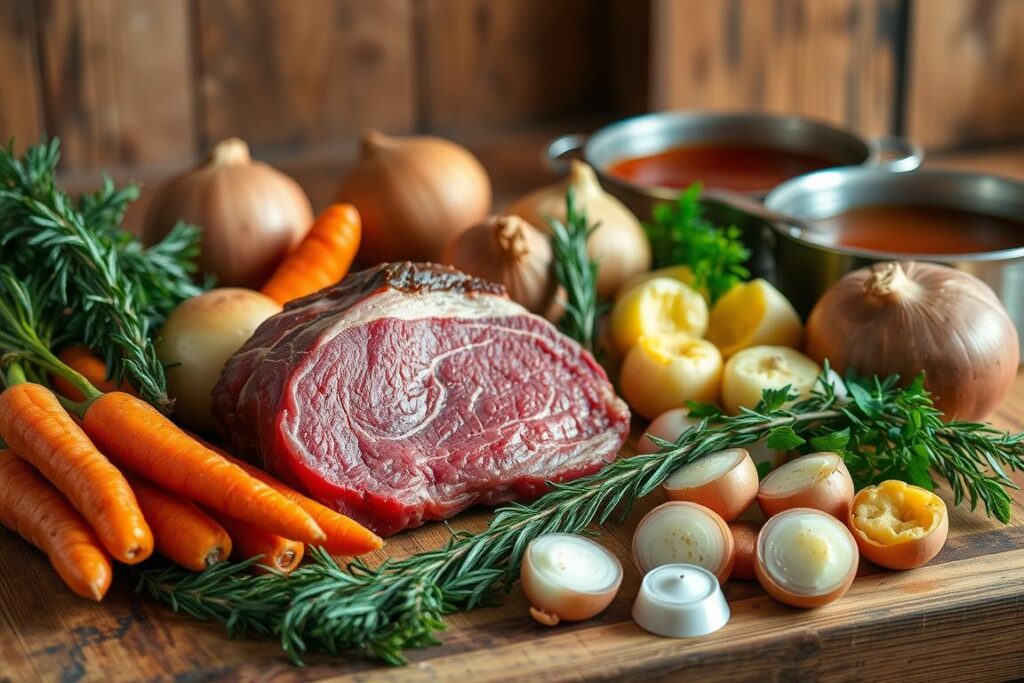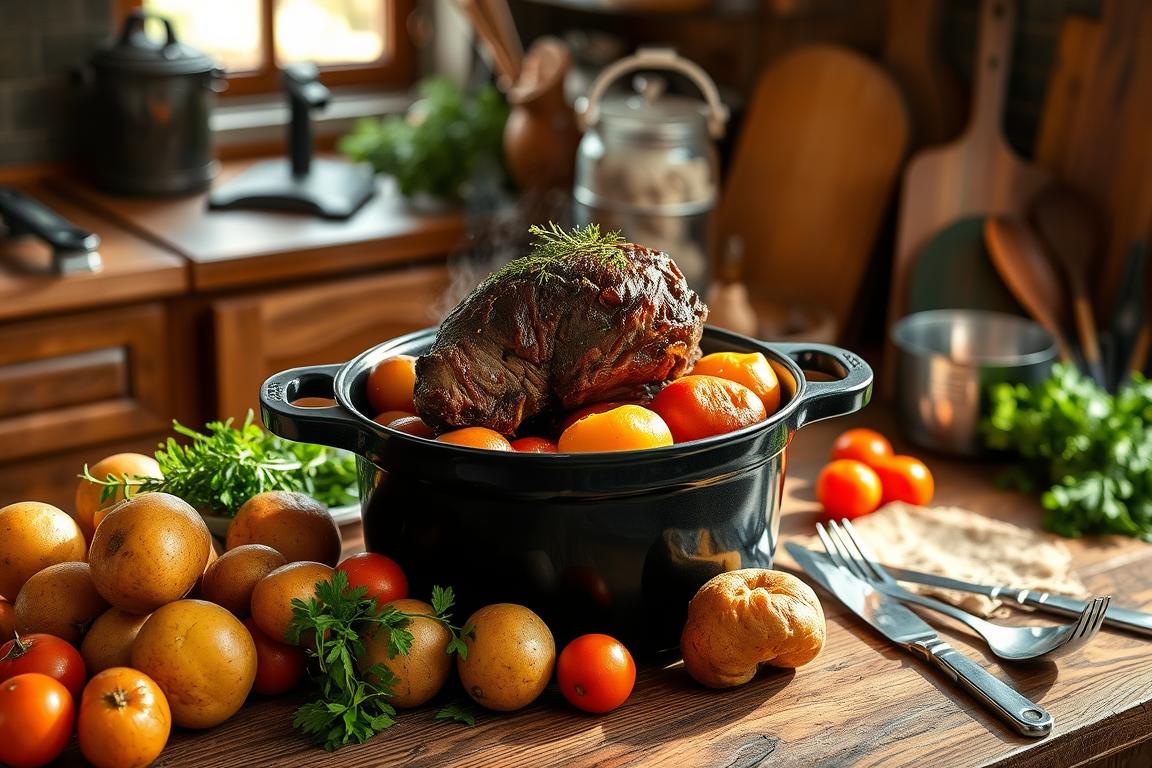My grandmother’s kitchen always smelled of home-cooked comfort. This was thanks to her pot roast cooking in a cast-iron Dutch oven. Those memories sparked my journey into understanding the art of pot roast cooking.
When making a classic pot roast, a big question comes up: Should potatoes go on top or bottom? This choice can change the flavor, texture, and success of your meal.
Pot roast is more than a meal; it’s a tradition that turns tough beef into tender, juicy meat. The right potato placement is key to blending flavors and making each ingredient shine.
Getting potatoes right in pot roast involves understanding cooking science, heat, and how ingredients work together. Whether you’re experienced or new, learning these techniques will make your pot roast amazing.
In the next sections, we’ll explore the science, strategies, and secrets of making the perfect pot roast. Your family will be asking for seconds.
Understanding the Science of Pot Roast Cooking
Cooking a perfect pot roast is an art that mixes science with tradition. It’s about using the right techniques to make tough meat tender and tasty.

Looking into one-pot meals shows us how heat and moisture work together. Knowing how these elements interact is key to a great dish.
Heat Distribution and Moisture Flow
Heat spreads through your pot roast in certain ways, creating different cooking areas. Important factors include:
- Meat cut selection
- Cooking vessel type
- Temperature control
- Moisture retention techniques
The Role of Layering in One-Pot Meals
Layering ingredients wisely can greatly enhance your pot roast. Each ingredient cooks best at its own time and temperature.
| Ingredient | Cooking Time | Placement |
|---|---|---|
| Beef Chuck | 3-4 hours | Bottom Layer |
| Root Vegetables | 2-3 hours | Middle Layer |
| Delicate Vegetables | 1-2 hours | Top Layer |
Temperature Zones in Dutch Ovens
Dutch ovens have special temperature areas for even cooking. Knowing these zones helps manage moisture and tenderness in your pot roast.
By learning these techniques, you can turn simple ingredients into a delicious dish. It’s a story of science and comfort in every bite.
Essential Ingredients for the Perfect Pot Roast
Making a great pot roast starts with picking the right ingredients. Your choice of ingredients is key to making those classic pot roast recipes. They fill your kitchen with delicious smells.

Selecting the Right Cut of Meat
For a pot roast that’s tender and full of flavor, choose a chuck roast. It should weigh 4 to 5 pounds. This cut is known for its marbling, which makes it tender and flavorful.
Look for meat with visible fat streaks. These will melt and make the dish rich and juicy.
Vegetable Preparation Guidelines
- Select 6-8 carrots, cut into 2-inch slices
- Use 2 onions, halved from root to tip
- Choose medium-sized russet potatoes for hearty chunks
- Wash and roughly chop vegetables for even cooking
Seasoning and Aromatics Selection
Enhance your pot roast with the right seasonings. Here are some classic choices:
- Fresh herbs: 3-4 sprigs of rosemary
- Fresh thyme: approximately 3 sprigs
- Kosher salt: 1 tablespoon
- Freshly ground black pepper: 1 teaspoon
Pro tip: Fresh herbs can really boost your pot roast’s taste. They make your dish unforgettable.
Do potatoes go on top or bottom of pot roast?
When making a pot roast, where you put the potatoes matters a lot. It affects the taste and texture of your dish. Knowing the best way to layer potatoes is key to a great meal.
The right way to layer potatoes in pot roast depends on a few things:
- Cooking method (oven, slow cooker, or Instant Pot)
- Desired vegetable texture
- Meat and vegetable cooking order
For most pot roast recipes, putting potatoes at the bottom is best. This way, they:
- Absorb rich meat juices
- Create a flavorful base
- Prevent meat from sticking to the pot
How long you cook the potatoes depends on their size. For larger potato chunks (2-3 inches), add them 60 to 90 minutes before finishing. Smaller pieces should go in 45 to 60 minutes before cooking is complete. Cooking at 275 degrees Fahrenheit ensures tender meat and veggies.
When choosing between top or bottom for potatoes, think about your recipe and what you want. Each cooking method might need a little tweak to get the perfect pot roast with great potatoes.
The Art of Layering Vegetables in Pot Roast
Mastering the art of layering vegetables in pot roast is key to a delicious meal. The right arrangement of ingredients can turn a simple dish into a masterpiece.
Root Vegetable Placement Strategy
When you’re setting up your pot roast, where you place the vegetables matters. Root veggies like carrots and potatoes need a special spot for even cooking and to soak up flavors.
- Place dense root vegetables at the bottom of the pot
- Arrange vegetables around the meat for optimal heat distribution
- Use larger vegetable chunks to prevent overcooking
Managing Cooking Times for Different Vegetables
Each vegetable cooks at its own pace. Think about the thickness and moisture of each when you layer your pot roast.
| Vegetable | Cooking Time | Placement Recommendation |
|---|---|---|
| Carrots | 4-6 hours | Bottom layer |
| Potatoes | 4-5 hours | Surrounding meat |
| Onions | 3-4 hours | Top layer |
Preventing Vegetable Mushiness
To keep vegetables from getting mushy, cut them into larger, uniform pieces. This keeps their texture while letting them soak up the pot roast’s rich flavors.
- Cut vegetables into 1-2 inch chunks
- Add softer vegetables later in the cooking process
- Avoid overcrowding the pot
Mastering Cooking Techniques for Tender Results
Preparing a traditional pot roast requires understanding cooking techniques for that tender taste. The secret is patience and controlling the temperature.
The size of your pot roast matters. A 2-3 pound chuck roast is ideal for flavor and texture. Cook it low and slow, at 325°F, for the best tenderness.
- Slow cooker method: 9-10 hours on low heat
- Oven method: 7-8 hours at low temperature
- Pressure cooker method: 15 minutes high pressure
Experts say to check the meat’s tenderness after 6 hours. The best results come between 7-8 hours. This process breaks down tough meat into a tender dish.
| Cooking Method | Time | Temperature |
|---|---|---|
| Slow Cooker | 9-10 hours | Low heat |
| Oven | 7-8 hours | 325°F |
| Pressure Cooker | 15 minutes | High pressure |
Remember, patience is key. If your beef isn’t tender, it needs more time. Different cuts might need different cooking times. Always check and adjust your recipes as needed.
Troubleshooting Common Pot Roast Problems
Pot roast cooking can sometimes present challenges that even experienced home chefs encounter. Understanding common issues with pot roast cooking techniques will help you create a more delicious and consistent meal every time.
Addressing Uneven Cooking Issues
Uneven cooking often results from improper meat preparation or incorrect temperature management. To ensure consistent pot roast doneness levels, consider these strategies:
- Bring meat to room temperature before cooking
- Use a meat thermometer to check internal temperature
- Rotate meat halfway through cooking process
- Ensure even distribution of vegetables around the roast
Solutions for Overcooked Vegetables
Overcooked vegetables can destroy the pot roast flavors and textures you’re aiming to achieve. Prevent mushy vegetables by:
- Adding root vegetables later in the cooking process
- Cutting vegetables into larger, uniform chunks
- Monitoring cooking time carefully
- Placing harder vegetables like carrots at the bottom of the pot
Fixing Texture Problems
If your pot roast turns out tough, don’t despair. Professional chefs recommend these rescue techniques:
- Cut meat against the grain
- Return sliced meat to pot juices
- Let meat rest in liquid for 10-15 minutes
- Use a slow cooker or low oven temperature
Pro tip: Choosing a well-marbled chuck roast can significantly improve your dish’s tenderness and overall flavor profile.
Conclusion
Mastering pot roast cooking takes practice and patience. You can try placing potatoes on top or bottom to see what you like best. It’s all about finding the right way to make your one-pot meal.
When cooking pot roast, remember to focus on cooking time and temperature. A tough cut of meat becomes tender and flavorful with slow cooking. Cooking it for 4-6 hours on high or 6-8 hours on low is key for that perfect texture.
Where you put the potatoes can change the dish a lot. Some people put them at the bottom for even cooking, while others like them on top. Pot roast is all about trying different things to find what works best for you.
With time, you’ll get better at making pot roast that’s not just filling but also heartwarming. Your cooking skills will show in every dish, making meals special and enjoyable.
FAQ
Should potatoes go on top or bottom of pot roast?
It depends on your cooking method and what you want. Putting potatoes on the bottom helps them soak up more juices and taste better. They also help the meat not burn by sitting on a natural rack.
How long should I cook a pot roast with potatoes?
Cook it for 3-4 hours at 325°F. This makes the meat tender and the potatoes fully cooked but not mushy.
Can I add potatoes at different stages of cooking?
Yes, add potatoes in the last 1-2 hours. This keeps them from getting too soft while they soak up meat flavors.
What type of potatoes work best for pot roast?
Use waxy potatoes like Yukon Gold or red potatoes. They stay firm and add a creamy texture. Avoid starchy potatoes like Russets.
How do I prevent potatoes from getting mushy?
Cut potatoes into big, even pieces and add them late. Don’t stir too much. Big chunks keep their shape better.
Can I make pot roast with other root vegetables?
Yes! Carrots, parsnips, and turnips are great with potatoes. They cook together well, adding flavor and nutrition.
What’s the best cut of meat for pot roast?
Chuck roast is the best. It’s tough but gets tender with slow cooking. Its collagen makes the meat rich and tender.

